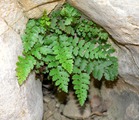090501 Cystopteris fragilis (L.) Bernh.
Distribution
Northern Iceland: Frequent
Northern Fennoscandia: Frequent
Kanin - Pechora: Rare
Svalbard - Franz Joseph Land: Scattered
Polar Ural - Novaya Zemlya: Scattered
Yamal - Gydan: Rare
Taimyr - Severnaya Zemlya: Scattered
Anabar - Onenyo: Scattered
Kharaulakh: Scattered
Yana - Kolyma: Rare
West Chukotka: Frequent
Wrangel Island: Rare
South Chukotka: Frequent
East Chukotka: Frequent
Western Alaska: Frequent
Northern Alaska - Yukon: Frequent
Central Canada: Frequent
Hudson Bay - Labrador: Frequent
Ellesmere Island: Scattered
Western Greenland: Frequent
Eastern Greenland: Frequent
Northern arctic Tundra: Rare
Mid Arctic Tundra: Frequent
Southern Arcti Tundra: Frequent
Shrub Tundra: Frequent
Bordering boreal or alpine areas: Frequent
- Bernh., Neues J. Bot. 1, 2: 27 (1805). - Polypodium fragile L., Sp. Pl.: 1091 (1753) "filix-fragile". Lectotype (LINN): Europe. Herb. Linn. 1251.51, leg. Amman 52 (Copeland 1929: 56). - Cystopteris filixfragilis (L.) Borbás, Balaton Fl.: 314 (1900).
- Cystopteris dickieana R. Sim, Gard. Farmer's J. 2, 20: 308 (1848). Described from Scotland. - Cystopteris fragilis var. dickieana (R. Sim) T. Moore, Handb. Brit. Ferns: 81 (1848). - Cystopteris fragilis subsp. dickieana (R. Sim) Hook. f., Student Fl. Brit. Isl.: 464 (1870).
2n=
168 160-170 (4x). - Europe, Canada, USA, Greenland. - Numerous reports for both "fragilis" and "dickieana".
Not included: Reports of 2n = 252 (6x) and 336 (8x) from central Europe (Manton and Reichstein 1965; Vida 1974, 1980). These may belong to the related C. alpina (see below). Reports of 2n = 84 and 252 from India, Taiwan, and Japan may belong to other species.
Geography: Cosmopolitan: ICE NOR RUS SIB RFE ALA CAN GRL.
Notes: Plants with echinate spores ("fragilis" s. str) and rugose ones ("dickieana") have commonly been accepted as two species (Cystopteris fragilis, C. dickieana), two subspecies, or two varieties. In the Nordic area, rugose spores occur in several groups with morphologically different expressions (Elven 1984b), and plants with rugose spores occur occasionally within populations with echinate ones (Berg 1992, 2000). See Hagenah (1961) for a similar conclusion concerning North American plants. We have not found it possible to separate a taxon dickieana on macromorphology (Elven 1984b; Berg 1992, 2000). Even if plants with rugose spores have a certain geographic pattern (alpine to arctic), this seems to be geographical variation in one character, possibly with a very simple genetic explanation. The results of the molecular investigations of Dyer et al. (2000) and Parks et al. (2000) made these authors reject C. dickieana as a taxon. Vida's (1974) hypothesis that partly different diploid genomes partake in "fragilis" and "dickieana" has not found support and is countered by Parks et al. (2000).
-

''Cystopteris fragilis'' in upper north fork of Pine Creek Canyon, Red Rock Canyon, Spring Mountains, southern Nevada (elev. about 1500 m)
Source: Stan Shebs at Wikispecies
Higher Taxa
- Cystopteris [0905,genus]